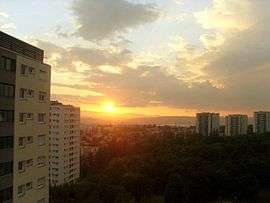Vénissieux
| Vénissieux | ||
|---|---|---|
|
Sunset over Vénissieux | ||
| ||
 Vénissieux | ||
|
Location within Auvergne-Rhône-Alpes region  Vénissieux | ||
| Coordinates: 45°41′52″N 4°53′12″E / 45.6978°N 4.8867°ECoordinates: 45°41′52″N 4°53′12″E / 45.6978°N 4.8867°E | ||
| Country | France | |
| Region | Auvergne-Rhône-Alpes | |
| Metropolis | Metropolis of Lyon | |
| Arrondissement | Lyon | |
| Area1 | 15.33 km2 (5.92 sq mi) | |
| Population (2012)2 | 61,183 | |
| • Density | 4,000/km2 (10,000/sq mi) | |
| Time zone | CET (UTC+1) | |
| • Summer (DST) | CEST (UTC+2) | |
| INSEE/Postal code | 69259 / 69200 | |
| Elevation |
171–229 m (561–751 ft) (avg. 186 m or 610 ft) | |
|
1 French Land Register data, which excludes lakes, ponds, glaciers > 1 km² (0.386 sq mi or 247 acres) and river estuaries. 2 Population without double counting: residents of multiple communes (e.g., students and military personnel) only counted once. | ||
Vénissieux (Vènissiœx in the Lyonnais dialect of Arpitan language) is a commune in the Metropolis of Lyon in Auvergne-Rhône-Alpes region in eastern France.
Geography
Vénissieux is located on the southern outskirts of Lyon.
Toponymy
The name Vénissieux derives from Latin Viniciacum, itself crafted upon a Roman villa landlord named Vinicius. Inhabitants are called 'Vénissians'.
History
In May 1944 the industries are damaged by the bombing (especially Berliet factories). On 2 September 1944, Vénissieux is freed from the Nazis.
Riots in September 1981, occurring particularly in the area of Les Minguettes, were some of the first of their kind in suburban neighborhoods in France. In summer 1983, harsh clashes were held between police and young people in the Minguettes neighborhood.
During the riots, Toumi Djaïdja, the young president of the association 'SOS Avenir Minguettes', was wounded by a policeman and rushed to the hospital. Police chases, cars burned, urban damage... These events are filmed and widely mediatised. Residents of the neighborhood, including the priest Christian Delorme and the pastor Jean Costil have the idea of a long walk, inspired by Martin Luther King, Jr and Gandhi. These events are at the origin of The March For Equality and Against Racism
Since the late 1980s, major urban renewal programs (mostly building implosions) have transformed the Minguettes neighborhood reducing high population density. Between 1990 and 1999, the district loses more than 2,000 citizens. Today Vénissieux is classified 'ZSP' for Priority Security Zone and still tarnished by his bad reputation because of high crime rate. The district is home of about 22,000 inhabitants. Unemployment affects 40% of youth.
The population of Vénissieux is diverse, result of several waves of successive immigrations with a large community from the Maghreb, Africa, Italy, Spain and Asia.
Transport
The city is situated between two boulevards. From south of the town we can reach the southern urban boulevard and from North we can join the Lyon ring road three doors that overlook the town : the gates of Parilly, Vénissieux center and the Moulin à Vent. The city is also very well served by the various means of transport by the TCL network. The last two, line D of the Lyon metro stations are located on its territory : Parilly Parc and the gare of Vénissieux, the Lyon's tramway T4 line and three bus lines.
Immigration
In 2008, the immigrant population was 13,846 people with 24% of the population (4.6% born in Europe) and 19.4% born outside Europe, mainly originating from Maghreb
Culture and Education
Monuments
Some monuments are really old, like "l'ecole du centre" or "l'école Pasteur". This two monuments were used by the Nazi during the second world War.
Culture
- Cinema Gérard-Philippe
- Music school Jean-Wiener
- Médiathèques Lucie-Aubrac, Robert-Desnos, Anatole-France, La Pyramide (neighborhood libraries)
Religion
- Evangelical, Protestant, Catholic churches
- Mosque Eyüb Sultan
The city offers a strong socio-educational project with nearly 60 institutions. It offers a favorable school education with a high density of schools throughout the city.
- There are regular confusion between the residents of Venissieux (Venissian, Venissianes) and with the city of Venice (Venetian).
- Vénissieux, a bit long to pronounce is often shortened to "Vé" in the current language residents ex: "Gare de Vé".
Personalities
- Omar Diantete, footballer
- Luis Fernández, footballer.
- Ludovic Giuly, footballer.
- Florence Foresti, humorist.
- Étienne Bally, former European Champion over 100 metres.
- Joseph-Désiré Job, footballer.
- Mehdi Senoussi, Actor, Producer,
- Samuel Dumoulin, Cyclist born here in 1984
Twin towns
-
 Joal-Fadiouth (Senegal)
Joal-Fadiouth (Senegal) -
 Manises (Spain)
Manises (Spain) -
 Nový Jičín (Czech Republic)
Nový Jičín (Czech Republic) -
 Oschatz (Germany)
Oschatz (Germany) -
 Zhodzina (Belarus)
Zhodzina (Belarus)
See also
References
External links
| Wikimedia Commons has media related to Vénissieux. |
- Official website (French)
- Localisation of the city of Vénissieux on a map of France
- Map of Vénissieux on Mapquest

